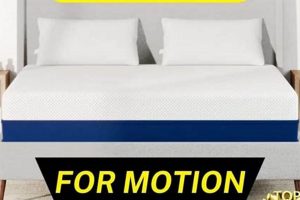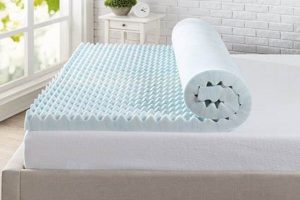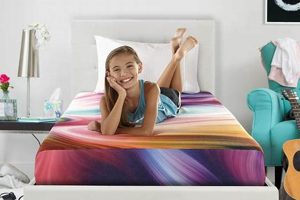A supplementary layer designed to enhance the comfort of a sofa bed’s sleeping surface is a frequently sought solution. This layer, typically composed of materials such as memory foam, latex, or down alternatives, aims to mitigate the thinness and often-uncomfortable construction of a standard sofa bed mattress. An example would be a two-inch memory foam pad placed atop a sofa bed mattress to provide improved support and pressure relief.
The utilization of such a layer can significantly improve the sleep quality experienced on a sofa bed. Addressing common complaints associated with sofa beds such as inadequate cushioning and the sensation of underlying support structures this addition contributes to a more restful and restorative sleep. Historically, individuals have sought ways to enhance the functionality and comfort of convertible furniture, and this represents a modern solution to a longstanding need.
Therefore, exploring factors such as material composition, thickness, density, and user reviews becomes essential in determining the optimal choice. The subsequent sections will delve into these considerations, offering guidance on selecting a suitable option to elevate the sleeping experience provided by a sofa bed.
Enhancing Sofa Bed Comfort
Selecting the appropriate supplementary sleep surface for a sofa bed necessitates careful evaluation of several factors. These considerations directly impact the user’s comfort and the longevity of the enhancement.
Tip 1: Prioritize Material Density: Higher density materials, particularly in memory foam, generally provide superior support and durability. A denser foam resists compression and maintains its shape for a longer duration.
Tip 2: Evaluate Thickness in Relation to Sofa Bed Mattress: The thickness should complement the existing mattress. An excessively thick addition on an already firm mattress may result in an uncomfortably stiff surface, while an insufficient thickness will not provide adequate support.
Tip 3: Consider Breathability and Temperature Regulation: Certain materials, such as latex or gel-infused memory foam, offer enhanced breathability. This is crucial for maintaining a comfortable sleep temperature, particularly in warmer climates or for individuals prone to overheating.
Tip 4: Assess Motion Isolation Properties: If the sofa bed is used by multiple individuals, consider materials with good motion isolation. Memory foam, for example, effectively absorbs movement, minimizing disturbance to other sleepers.
Tip 5: Examine Cover Material and Washability: A removable and machine-washable cover is essential for maintaining hygiene. Look for covers constructed from breathable fabrics to further enhance comfort.
Tip 6: Verify Dimensions and Fit: Accurate measurements are critical to ensure a proper fit on the sofa bed mattress. An ill-fitting addition can bunch up, shift during sleep, and detract from overall comfort.
Tip 7: Read User Reviews and Ratings: User reviews provide valuable insights into the real-world performance and durability of various options. Pay attention to comments regarding comfort, support, and longevity.
By carefully considering these factors, individuals can make informed decisions and significantly improve the comfort and usability of their sofa beds. The outcome will be a more supportive and restful sleep environment.
The subsequent section will address frequently asked questions related to sofa bed comfort enhancements.
1. Material Density
Material density is a critical determinant of a mattress topper’s performance and longevity, particularly in the context of optimizing a sofa bed for sleep. Density, often measured in pounds per cubic foot (lbs/ft), directly correlates with the amount of material packed into a given volume. Higher density materials provide greater support and resistance to compression, crucial for addressing the common issue of inadequate support in sofa bed mattresses. A low-density foam, for example, will quickly compress under weight, offering minimal cushioning and failing to alleviate pressure points. Conversely, a high-density memory foam topper will conform to the body while maintaining structural integrity, distributing weight more evenly and preventing the sleeper from sinking into the sofa bed’s underlying frame or support bars. The effect of high density material on the “best mattress topper for sofa bed” directly influences support and overall sleep quality.
Consider two scenarios: a sofa bed outfitted with a 2-inch memory foam topper with a density of 3 lbs/ft and another using a 2-inch topper with a density of 5 lbs/ft. The former, with its lower density, is likely to exhibit significant compression over time, leading to a flattened and uncomfortable sleep surface within a relatively short period. The latter, with its higher density, will retain its shape and support for a considerably longer duration, resisting indentation and providing consistent comfort. Furthermore, denser materials are less prone to breakdown and degradation, extending the lifespan of the addition and maintaining its performance over repeated use. The choice of the “best mattress topper for sofa bed” depends on its long-term effectiveness and durability.
In summary, material density is a fundamental consideration when selecting a sofa bed mattress topper. Higher density equates to enhanced support, improved durability, and sustained comfort, addressing the inherent shortcomings of many sofa bed mattresses. While the initial cost of a high-density option may be greater, the long-term benefits in terms of sleep quality and product longevity often justify the investment. Selection criteria for choosing the “best mattress topper for sofa bed” will be significantly impacted by this vital factor.
2. Thickness
Thickness is a defining characteristic in determining the effectiveness of a mattress topper, particularly when addressing the comfort limitations of a sofa bed. The selection of an appropriate thickness directly influences the level of support, pressure relief, and overall sleep quality experienced on the often-thin and unyielding surface of a sofa bed mattress.
- Support and Spinal Alignment
Thickness contributes significantly to spinal alignment. A thicker topper can provide additional cushioning, allowing the spine to maintain its natural curvature during sleep. Insufficient thickness may fail to provide adequate support, leading to discomfort and potential back pain. For instance, a sofa bed with pronounced support bars may require a thicker topper (e.g., 3-4 inches) to effectively mitigate the sensation of these bars pressing against the sleeper’s body. The best mattress topper for sofa bed must provide the proper support to prevent back pain.
- Pressure Point Relief
Adequate thi
ckness is essential for pressure point relief, particularly in areas such as the shoulders, hips, and knees. A thicker layer of conforming material, such as memory foam, can distribute weight more evenly, reducing stress on these pressure points. A thin topper (e.g., 1-2 inches) may not offer sufficient cushioning to alleviate pressure, resulting in discomfort and restlessness. The best mattress topper for sofa bed must evenly distribute weight to be effective. - Sofa Bed Design Constraints
The design of the sofa bed itself imposes limitations on the practical thickness of a topper. An excessively thick topper may prevent the sofa bed from folding up properly, rendering it unusable in its sofa configuration. Therefore, the selected thickness must strike a balance between comfort enhancement and functional compatibility with the sofa bed’s folding mechanism. This is a critical component of determining the “best mattress topper for sofa bed”.
- Material Composition and Density Interaction
The optimal thickness is also influenced by the topper’s material composition and density. A high-density memory foam topper may provide sufficient support at a lesser thickness compared to a low-density option. For example, a 3-inch high-density memory foam topper may offer comparable support to a 4-inch low-density topper. Therefore, thickness should be considered in conjunction with material properties to achieve the desired level of comfort and support when deciding on the best mattress topper for sofa bed.
In conclusion, thickness is a crucial factor in determining the suitability of a mattress topper for a sofa bed. It directly impacts support, pressure relief, and overall sleep comfort. However, the selection of an appropriate thickness must also consider the design constraints of the sofa bed and the material properties of the topper itself. A balanced approach, considering these factors, is essential for selecting the optimal thickness to maximize the comfort and usability of a sofa bed as a sleep surface to find the best mattress topper for sofa bed.
3. Firmness Level
Firmness level represents a critical determinant in the selection of a mattress topper, particularly when optimizing a sofa bed for sleep. The inherent characteristics of sofa bed mattresses, often thin and lacking in substantial support, necessitate careful consideration of firmness to address individual comfort preferences and orthopedic needs. A mattress topper deemed too soft may fail to provide adequate spinal alignment, exacerbating existing back pain or creating new discomfort. Conversely, a topper that is excessively firm can create pressure points, leading to restlessness and disturbed sleep. The selection of the “best mattress topper for sofa bed” therefore hinges significantly on aligning the firmness level with the user’s specific requirements and the characteristics of the existing sofa bed mattress. The importance of matching the firmness level to user needs cannot be overstated.
Consider, for example, an individual who primarily sleeps on their side. A softer topper may be more appropriate for this sleep position, allowing the shoulders and hips to sink slightly into the surface, thereby maintaining spinal alignment and reducing pressure point discomfort. In contrast, an individual who sleeps on their back may require a firmer topper to provide adequate support for the lumbar region, preventing the spine from sagging and minimizing the risk of back pain. Furthermore, the firmness level of the existing sofa bed mattress must be taken into account. A sofa bed mattress that is already quite firm may benefit from a softer topper to add a layer of cushioning, while a softer sofa bed mattress may require a firmer topper to provide additional support. This is critical when attempting to determine the “best mattress topper for sofa bed.”
In conclusion, the firmness level is a crucial consideration when choosing a mattress topper for a sofa bed. The ideal firmness will vary depending on individual sleep preferences, orthopedic needs, and the characteristics of the existing sofa bed mattress. Failing to adequately address this factor can result in discomfort, poor sleep quality, and potential exacerbation of pre-existing back problems. This interrelation should be meticulously analyzed in the assessment of which mattress topper is truly the “best mattress topper for sofa bed,” ensuring a comfortable and supportive sleep surface.
4. Size Accuracy
In the context of selecting an optimal mattress topper for a sofa bed, dimensional precision is paramount. Deviation from accurate measurements can negate the intended benefits, rendering the topper ineffective and potentially creating usability issues. The selection process must, therefore, prioritize verification of dimensions to align with the specific sofa bed mattress.
- Optimizing Comfort and Support
A mattress topper designed to enhance comfort and support relies on a consistent and uniform surface. An undersized topper will leave portions of the sofa bed mattress exposed, creating uneven support and disrupting sleep quality. Conversely, an oversized topper may bunch up, creating pressure points and reducing the overall comfort. Accurate sizing ensures that the intended benefits of the topper, such as pressure relief and spinal alignment, are realized across the entire sleep surface.
- Preventing Damage and Wear
Imprecise dimensions can contribute to premature wear and tear of both the topper and the sofa bed mattress. An oversized topper, forced to fit, may experience stress along its edges, leading to tearing or deformation of the material. An undersized topper, failing to fully protect the underlying mattress, can leave it vulnerable to stains, spills, and general wear. Proper sizing minimizes these risks, extending the lifespan of both the topper and the sofa bed mattress.
- Ensuring Functional Compatibility
Sofa beds are characterized by their dual-purpose functionality, serving as both seating and sleeping surfaces. A mattress topper that does not conform precisely to the dimensions of the sofa bed mattress can impede the folding mechanism, preventing the sofa bed from transitioning smoothly between its two configurations. Accurate sizing is, therefore, essential to maintain the functional integrity of the sofa bed.
- Aesthetic Considerations
Beyond practical considerations, size accuracy contributes to the overall aesthetic appeal of the sofa bed. A well-fitting topper creates a clean and uniform appearance, enhancing the visual appeal of the furniture. An ill-fitting topper, by contrast, can detract from the aesthetic, creating a cluttered and unkempt impression. Proper dimensions therefore contribute to both the functional and aesthetic qualities of the sleep enhancement.
The criticality of size accuracy underscores its role in achieving the intended goals of a mattress topper on a sofa bed. By ensuring precise dimensional alignment, individuals can maximize comfort, minimize wear and tear, maintain functional compatibility, and enhance the aesthetic appeal, ultimately improving the overall quality and utility of the sofa bed sleeping experience. Therefore, size is an elementary yet crucial feature to get right when attempting to obtain the “best mattress topper for sofa bed”.
5. Breathability
Breathability, pertaining to a mattress topper’s capacity to facilitate airflow and dissipate heat, directly influences the sleep experience, particularly on sofa beds. Sofa beds often present inherent challenges regarding temperature regulation due to their construction and limited ventilation. This condition amplifies the importance of a topper’s breathability. A non-breathable topper can trap heat and moisture, creating an uncomfortable microclimate that disrupts sleep and promotes night sweats. Conversely, a breathable topper allows for efficient airflow, helping to maintain a cooler and drier sleep surface. An illustrative example is a latex topper with open-cell structure, which inherently promotes air circulation, compared to a traditional closed-cell memory foam topper that tends to retain heat. The effectiveness of a “best mattress topper for sofa bed” is inextricably linked to its breathable characteristics.
The selection of materials plays a pivotal role in determining a topper’s breathability. Natural fibers, such as cotton or wool, exhibit superior breathability compared to synthetic materials like polyester. Gel-infused memory foam, designed with open-cell structures, represents an attempt to mitigate the heat retention associated with traditional memory foam. However, the actual performance varies depending on the specific manufacturing process and the density of the foam. The design of the topper also contributes to breathability. Toppers with quilted patterns or ventilated channels facilitate airflow, enhancing their ability to dissipate heat and moisture. An increased emphasis on breathability stems from the objective to construct the “best mattress topper for sofa bed”.
In summary, breathability is a crucial attribute of a mattress topper intended for use on a sofa bed. Its impact on temperature regulation and sleep comfort cannot be understated. Careful consideration of material selection, topper design, and individual sleep preferences is essential in optimizing the sleep experience on a sofa bed. A well-chosen, breathable topper can significantly mitigate the thermal challenges associated with sofa beds, resulting in a more restful and restorative sleep. Breathability is therefore a core component of what constitutes the “best mattress topper for sofa bed,” serving as a marker of sleep enhancing qualities.
6. Motion Isolation
Motion isolation, the ability of a mattress topper to minimize the transfer of movement, is a critical factor in determining the suitability of the “best mattress topper for sofa bed,” particularly when the sofa bed is shared by two individuals. The thin mattress and often less-stable support structure of a sofa bed can amplify motion transfer, disrupting the sleep of one occupant due to the movements of the other. A topper with superior motion isolation properties mitigates this effect, allowing for a more restful night’s sleep. For instance, a couple sharing a sofa bed might find that a memory foam topper significantly reduces disturbances caused by one partner’s tossing and turning throughout the night, preventing sleep fragmentation. The cause and effect relationship is clear: minimized motion transfer leads to improved sleep quality.
The material composition of the topper plays a significant role in motion isolation. Memory foam, known for its viscoelastic properties, excels at absorbing movement. Latex also provides good motion isolation, although to a lesser extent than memory foam. In contrast, toppers made of innerspring or down alternatives typically offer less effective motion isolation. The density and thickness of the topper also influence its ability to dampen movement; a thicker, denser topper generally provides better motion isolation than a thinner, less dense one. The choice of material should therefore be guided by the need to minimize motion transfer and maximize sleep quality.
In conclusion, motion isolation is a crucial attribute for a mattress topper intended for sofa bed use, especially when shared by two sleepers. Toppers with effective motion isolation, such as those made of memory foam, can significantly reduce sleep disturbances caused by movement transfer, promoting more restful and undisturbed sleep. Consideration of this attribute should be an integral part of the selection process when seeking the “best mattress topper for sofa bed,” as it directly impacts the sleep quality and overall satisfaction of the users. Prioritizing motion isolation characteristics enhances the potential for a comfortable and undisturbed sleep experience, which is paramount for any shared sleeping space.
7. Durability
Durability represents a primary determinant in the assessment of a mattress topper, especially within the context of sofa beds. Given the typically limited lifespan and inherent support deficiencies of sofa bed mattresses, the longevity of any supplementary comfort layer becomes paramount. A mattress topper lacking in durability will rapidly degrade, negating its intended benefits and necessitating frequent replacement. This frequent replacement creates a negative cost-benefit relationship, which disqualifies many mattress toppers from being classified as the “best mattress topper for sofa bed”. Consider the scenario of a memory foam topper with low density; despite initially providing comfort, this topper may quickly compress and lose its supportive qualities within a year, rendering it ineffective. The long term endurance of any mattress topper is crucial to achieving optimal value.
The selection of materials and manufacturing processes significantly impacts a topper’s durability. High-density memory foam, latex, and carefully constructed fiber blends generally exhibit greater resistance to compression and wear compared to lower-quality alternatives. Reinforced stitching, robust cover fabrics, and treatments to resist staining and degradation also contribute to extended product life. For example, a latex topper, known for its resilience, can maintain its shape and support for several years, even under consistent use, contrasting sharply with a budget polyester topper that may flatten and tear within months. Therefore, in any consideration of identifying the “best mattress topper for sofa bed,” material composition must be weighed strategically to maximize the product’s lifecycle.
In conclusion, durability is inextricably linked to the value proposition of a sofa bed mattress topper. A product that fails to maintain its structural integrity and comfort characteristics over a reasonable period represents a poor investment, irrespective of its initial price or purported features. By prioritizing durability, consumers can ensure that their chosen topper continues to enhance the sleep experience on their sofa bed for years to come, directly addressing the inherent limitations of the underlying mattress and establishing the “best mattress topper for sofa bed” as a worthwhile and sustained solution.
Frequently Asked Questions
This section addresses common inquiries regarding mattress toppers for sofa beds, offering objective information to aid in informed decision-making.
Question 1: Does any mattress topper suitably enhance sofa bed comfort?
No. Suitability hinges on matching the toppers characteristics (material, thickness, firmness) to both the sofa
bed’s existing mattress and the sleeper’s needs. A generic topper may not adequately address specific comfort deficits.
Question 2: How does material density influence topper performance on a sofa bed?
Higher density materials, notably in memory foam, offer greater support and resistance to compression, critical for compensating for the often-thin and unsupportive nature of sofa bed mattresses. Lower density materials degrade rapidly and provide minimal long-term benefit.
Question 3: Is an excessively thick topper always preferable for a sofa bed?
No. While thickness contributes to comfort, excessive thickness can impede the sofa bed’s folding mechanism. Thickness must be balanced with functional compatibility and the existing mattress’s firmness.
Question 4: How does breathability relate to sleep quality on a sofa bed?
Sofa beds often lack adequate ventilation, making breathability crucial. A breathable topper facilitates airflow, preventing heat retention and promoting a cooler, more comfortable sleep environment.
Question 5: What role does motion isolation play when selecting a topper for a shared sofa bed?
Motion isolation minimizes the transfer of movement between sleepers, particularly important on sofa beds where motion can be amplified. Toppers with good motion isolation, such as memory foam, reduce sleep disturbances.
Question 6: How can users evaluate the long-term durability of a mattress topper for a sofa bed?
Assess the material composition, manufacturing quality, and user reviews. High-density materials, reinforced stitching, and positive feedback regarding longevity indicate greater durability and a more sustained benefit.
These questions highlight key considerations for selecting a mattress topper to improve sofa bed comfort. Prioritizing these factors can lead to a more informed purchase decision and a more satisfactory sleep experience.
The concluding section will summarize key points and provide recommendations for selecting an optimal mattress topper.
Concluding Remarks on Selecting the Best Mattress Topper for Sofa Bed
This exploration has underscored the multifaceted nature of choosing the best mattress topper for sofa bed. Factors such as material density, thickness, firmness, size accuracy, breathability, motion isolation, and durability all contribute to the overall effectiveness of the addition. A failure to adequately address these elements can result in a suboptimal sleep experience, negating the intended benefits and potentially exacerbating existing comfort issues associated with sofa beds.
The ultimate selection should be guided by a comprehensive assessment of individual sleep preferences, existing sofa bed mattress characteristics, and a careful evaluation of product specifications and user feedback. By prioritizing these considerations, individuals can make an informed decision and significantly enhance the sleep quality and usability of their sofa bed. Continual assessment and refinement of selection criteria will inevitably lead to ongoing advancements in sofa bed comfort technology and enhance the overall sleep experience.



![Top-Rated: Best Mattress for Teenager [Sleep Better!] Organic & Natural Mattress Buyer’s Guide: Non-Toxic Sleep Solutions Top-Rated: Best Mattress for Teenager [Sleep Better!] | Organic & Natural Mattress Buyer’s Guide: Non-Toxic Sleep Solutions](https://mattressworldpa.com/wp-content/uploads/2025/07/th-7617-300x200.jpg)



![Top-Rated Best Folding Cot with Mattress [2024 Guide] Organic & Natural Mattress Buyer’s Guide: Non-Toxic Sleep Solutions Top-Rated Best Folding Cot with Mattress [2024 Guide] | Organic & Natural Mattress Buyer’s Guide: Non-Toxic Sleep Solutions](https://mattressworldpa.com/wp-content/uploads/2025/07/th-7613-300x200.jpg)